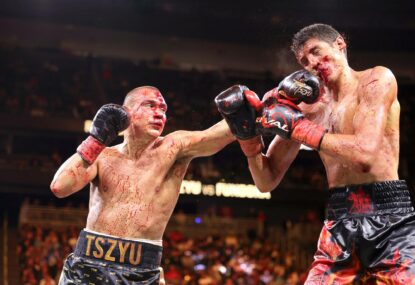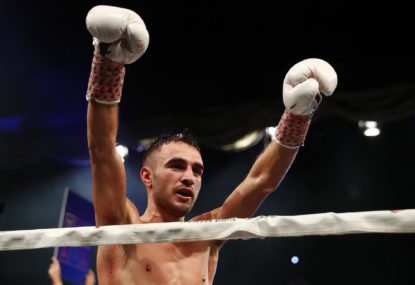This Saturday, California-based fight promotion Bellator present a circus attraction disguised as an MMA event, headlined by a bout between UFC Hall of Famers Ken Shamrock and Royce Gracie – two men with a combined age of 101.
Shamrock, a beefy 52-year-old with a helmet of graying hair and arms bigger than his opponent’s legs, has only won two fights over the past decade, and after one of those he flunked a drug test.
His opponent, three-time UFC tournament champion Gracie, hasn’t fought since a 2007 win over battle-tested Japanese fighter Kazushi Sakuraba, which was later overturned when he also failed a drug test.
It seems like some kind of sick joke for these ex-athletes who are well past their expiration date to compete in a 400-metre foot race, let alone a sanctioned cage fight, but that’s precisely what Bellator president Scott Coker is presenting on Saturday afternoon.
In some ways, you have to admire Coker’s hustle. More than even before, the UFC houses the overwhelming majority of elite fighters, making it increasingly hard to present a comparable product.
Basically, Coker is handcuffed. But instead of matching UFC talent-for-talent, the seasoned carnival barker is banking on nostalgia, bringing in dated acts and bizarre spectacles to draw eyeballs to their broadcast home on Spike TV in the United States.
And it has worked. Last year, the Bellator president presented Shamrock against famous web brawler Kevin ‘Kimbo Slice’ Ferguson. The fight was abysmal, so poor that many fans speculated that it was fixed. Despite that, it was a ratings bonanza, peaking with 2.1 million viewers and averaging 1.58 million for the three-hour broadcast.
The Viacom-owned Bellator company has discovered that presenting high-quality championship fights between lesser names delivers a fraction of the audience as these freak-show fights.
Under it’s initial leadership from founder Bjorn Rebney, Bellator was a league that focused on securing a foothold as more of a sports than entertainment property.
Fighters were never gifted major fights due to marketability or a grudge with the champion – the only way to earn a title shot was by going through a grueling three-month tournament.
Rebney’s formula for MMA with more of a sporting edge than the star-driven UFC was intriguing, yet ultimately flawed, and failed to develop into anything beyond a mild ratings success for Viacom.
Since the formative years of prizefighting in every form, promoters have sold the combination of art, entertainment, skill and spectacle to ticket buyers, television viewers and, eventually, pay-per-view consumers.
Coker, the new Bellator president, understands this better than most. Since taking command of the fledgling promotion, they have shattered personal-best records for both television ratings and live attendance.
There’s no mistaking that the former Strikeforce boss is getting results by pushing the envelope but is heading into unchartered and quite frankly, dangerous territory by scheduling a fight between Shamrock and Gracie. They are two broken-down, beaten-up old fighters who had their prime years when some of Bellator’s most loyal viewers were still in nappies.
By preying on the morbid curiosity of channel flippers, the fight is expected to be a major hit – on par with their previous effort for Shamrock versus Ferguson, if not greater.
And even though I and many others have objections over either man strapping on a pair of fingerless MMA gloves to compete in 2016, Coker and company aren’t breaking any rules or employing nefarious business practices. Both Shamrock and Gracie have passed their physicals and have been licensed to fight in the state of Texas.
The key word there being Texas, an athletic commission that has developed a reputation as an anything-goes regulatory body.
The Texas Department of Licensing and Regulation (TDLR), the agency in charge of making sure rules and regulations are followed in the state, is the same outfit that employed Dr Hector Oscar Molina. This was both before and after he confessed to injecting hulking heavyweight MMA fighter Alistair Overeem with a four-drug cocktail that contained testosterone.
In 2010, the commission even gave boxer Antonio Margarito the green light to compete in a lucrative bout with Manny Pacquiao after he served his one-year suspension in California for attempting to wrap plaster inserts into his gloves during a fight with Shane Mosely.
Both California and Nevada denied the American-born Mexican fighter’s license attempt, and the Association of Boxing Commissions (ABC) advised state regulatory agencies to order Margarito to appear in person before applying for a license to plead his case and explain his actions. He didn’t, but was still cleared to compete in the fight that netted $64 million in pay-per-view revenue alone.
Whether more respected regulatory bodies like Nevada, New Jersey or California would green light Shamrock versus Gracie III in 2016 is unclear, but if I were a betting man I would wager against it.



































































































